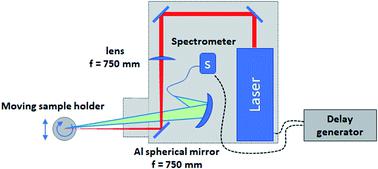当前位置:
X-MOL 学术
›
J. Anal. At. Spectrom.
›
论文详情
Our official English website, www.x-mol.net, welcomes your feedback! (Note: you will need to create a separate account there.)
Rapid chemical analysis of steel slag by laser-induced breakdown spectroscopy for near-the-line applications
Journal of Analytical Atomic Spectrometry ( IF 3.4 ) Pub Date : 2020-07-09 , DOI: 10.1039/d0ja00188k J. Petersson 1, 2, 3 , M. Gilbert-Gatty 1, 2, 3 , A. Bengtson 1, 2, 3
Journal of Analytical Atomic Spectrometry ( IF 3.4 ) Pub Date : 2020-07-09 , DOI: 10.1039/d0ja00188k J. Petersson 1, 2, 3 , M. Gilbert-Gatty 1, 2, 3 , A. Bengtson 1, 2, 3
Affiliation

|
A laser-induced breakdown spectrometry (LIBS) system for rapid slag analysis near a steel process has been tested and evaluated. The system consists of a Quantel CFR YAG laser with repetition rate 10 Hz, pulse energy at 1064 nm 300 mJ, a 75 cm lens to focus the laser beam onto the sample, a spherical aluminum mirror in a near-colinear configuration to collect the plasma emission, and dual Avantes CCD spectrometers. The system also includes a rotating/oscillating sample holder to achieve averaging over a sufficiently large sample area (volume) in order to get a representative measurement of the rather inhomogeneous slag samples. It was found that signal averaging over several hundred laser pulses was needed in order to get a statistically robust measurement of the average intensities. A large number of slag samples analyzed by X-ray fluorescence (XRF) were used to calibrate the LIBS system, using a univariate method adapted from spark OES (ratio method). The quantitative LIBS results were verified against the XRF data, with overall excellent agreement for the major components CaO, MgO, SiO2, Al2O3, FeO and MnO. The repeatability and reproducibility of the LIBS quantitative results were investigated. It was found that the relative standard deviation (RSD) for the major components were 2–4 times higher for LIBS compared with XRF. These results are adequate for several near-the-line applications, but can probably be considerably improved. A near-the-line measurement campaign in a steel plant demonstrated that the system is well-adapted to the industrial environment. A comparison of spectra of hot (∼1200 °C) and cold slags indicates that the ionization temperature of the LIBS plasma increases with sample temperature. This shows that further work is needed to develop “transfer functions” from calibration performed at room temperature. A first investigation of the possibility to separate the content of metallic iron from iron oxide by a pulse distribution analysis (PDA) technique was carried out. The results are very promising, indicating that LIBS can be a fast and accurate technique for this purpose.
中文翻译:

激光诱导击穿光谱法对钢渣进行快速化学分析,用于近线应用
已测试并评估了用于在钢厂附近进行快速熔渣分析的激光诱导击穿光谱(LIBS)系统。该系统包括一个重复频率为10 Hz的Quantel CFR YAG激光器,在1064 nm处的脉冲能量为300 mJ,一个75 cm透镜将激光束聚焦到样品上,一个接近共线配置的球形铝镜以收集等离子体发射和双Avantes CCD光谱仪。该系统还包括一个旋转/摆动的样品架,可以在足够大的样品区域(体积)上求平均值,从而获得相当不均匀的炉渣样品的代表性测量结果。已经发现需要平均数百个激光脉冲的信号,以便获得统计强度的平均强度测量值。使用通过火花OES改编的单变量方法(比例法),通过X射线荧光(XRF)分析的大量炉渣样品用于校准LIBS系统。相对于XRF数据验证了LIBS定量分析结果,其主要成分CaO,MgO,SiO的总体一致性极好2,铝2 O 3,FeO和MnO。研究了LIBS定量结果的可重复性和可重复性。研究发现,与XRF相比,LIBS的主要成分的相对标准偏差(RSD)高2-4倍。这些结果对于几种近线应用是足够的,但是可能会大大改善。一家钢铁厂的一次在线测量活动表明,该系统非常适合工业环境。热渣(〜1200°C)和冷渣光谱的比较表明,LIBS等离子体的电离温度随样品温度的升高而增加。这表明需要进一步的工作来开发在室温下执行的“传递函数”。首次研究了通过脉冲分布分析(PDA)技术从氧化铁中分离出金属铁含量的可能性。结果非常有希望,表明LIBS可以是一种快速而准确的技术。
更新日期:2020-09-02
中文翻译:

激光诱导击穿光谱法对钢渣进行快速化学分析,用于近线应用
已测试并评估了用于在钢厂附近进行快速熔渣分析的激光诱导击穿光谱(LIBS)系统。该系统包括一个重复频率为10 Hz的Quantel CFR YAG激光器,在1064 nm处的脉冲能量为300 mJ,一个75 cm透镜将激光束聚焦到样品上,一个接近共线配置的球形铝镜以收集等离子体发射和双Avantes CCD光谱仪。该系统还包括一个旋转/摆动的样品架,可以在足够大的样品区域(体积)上求平均值,从而获得相当不均匀的炉渣样品的代表性测量结果。已经发现需要平均数百个激光脉冲的信号,以便获得统计强度的平均强度测量值。使用通过火花OES改编的单变量方法(比例法),通过X射线荧光(XRF)分析的大量炉渣样品用于校准LIBS系统。相对于XRF数据验证了LIBS定量分析结果,其主要成分CaO,MgO,SiO的总体一致性极好2,铝2 O 3,FeO和MnO。研究了LIBS定量结果的可重复性和可重复性。研究发现,与XRF相比,LIBS的主要成分的相对标准偏差(RSD)高2-4倍。这些结果对于几种近线应用是足够的,但是可能会大大改善。一家钢铁厂的一次在线测量活动表明,该系统非常适合工业环境。热渣(〜1200°C)和冷渣光谱的比较表明,LIBS等离子体的电离温度随样品温度的升高而增加。这表明需要进一步的工作来开发在室温下执行的“传递函数”。首次研究了通过脉冲分布分析(PDA)技术从氧化铁中分离出金属铁含量的可能性。结果非常有希望,表明LIBS可以是一种快速而准确的技术。


























 京公网安备 11010802027423号
京公网安备 11010802027423号